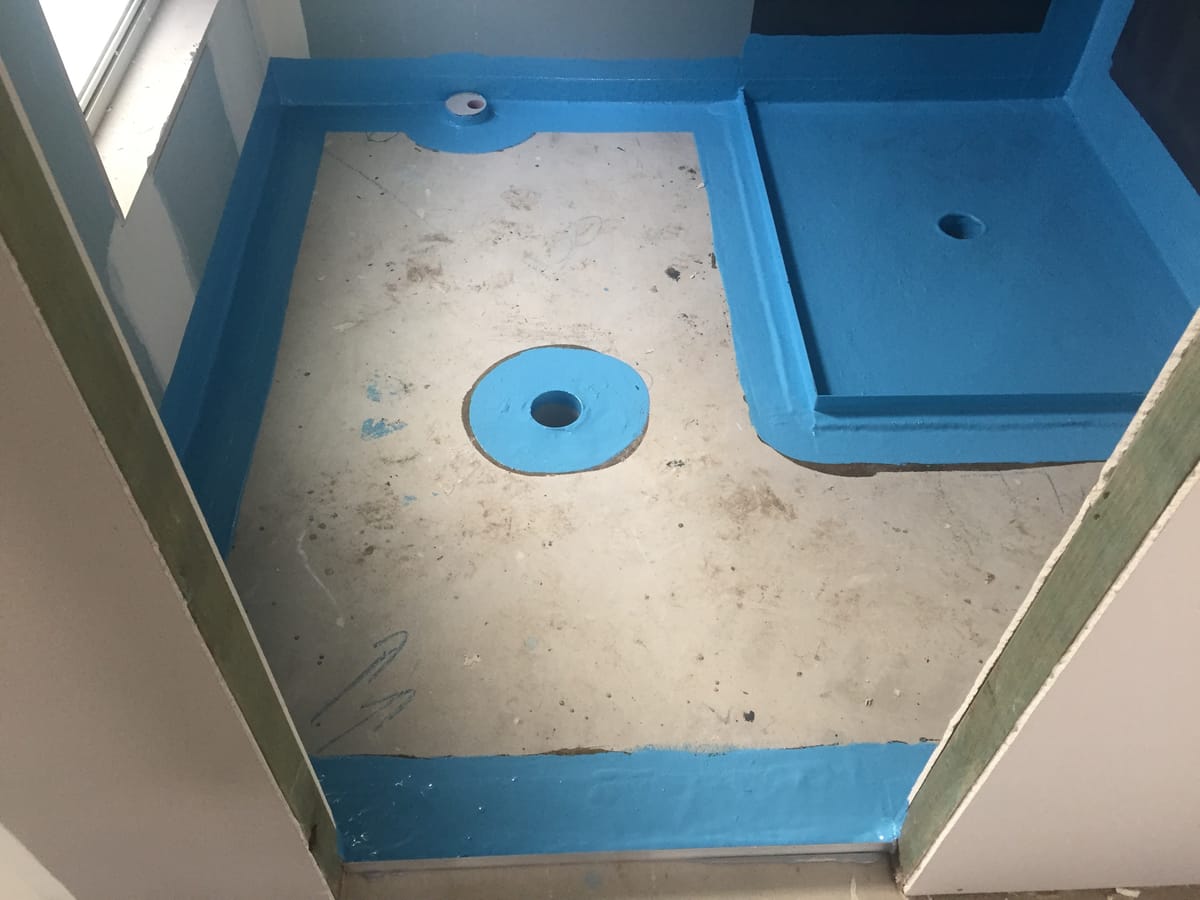You've come to the right place to learn all about residential construction and quality management. Before we forget, if someone forward you this newsletter, don't forget to subscribe to our newsletter so you never miss out!
🤗 Howdy Readers
In this newsletter, you'll find:
Our latest blog post "C13A Waterproofing design Checklist (its not as hard as you might think it is)". Post 2 - The Cantillon Effect. Post three + four we ask ChatGPT to review a specification from Balance Design & Construction & Hallmark Homes.
☔️ Waterproofing: The Part of Your Build That Really Can’t Go Wrong
Most homeowners don’t give waterproofing much thought — until their bathroom starts leaking, tiles lift, or mould creeps in. And by then? It’s usually too late (and too expensive). This week’s post breaks down the C13A Waterproofing Design Checklist — a tool that helps you get it right before a drop of membrane goes on.
We’ll show you what it is, why it matters, and how it helps you avoid the most common mistakes (like choosing the wrong membrane, ignoring curing conditions, or mixing incompatible products). If you’ve ever wondered how waterproofing should be planned — not just slapped on the day before tiling — this one’s for you.
👉 Read the full post by clicking the link below:

Post 2: Ever feel like the property market is rigged?
You’re not imagining it. This week’s post breaks down a little-known economic idea called the Cantillon Effect—a concept that quietly shapes house prices in Australia. It explains why those who get access to new money first (think banks and big investors) always seem to get ahead, while the rest of us are left playing catch-up with rising prices.
We unpack how this works, what it means for housing affordability, and most importantly—what you can do about it. Whether you're trying to buy your first home or just make sense of the chaos, this one’s worth a read.

Post 3+4: ChatGPT Analyses
Ever wondered what an artificial intelligence thinks about your potential home builder? We put one of Australia's largest construction companies under the microscope - using ChatGPT's analytical capabilities.
We use the same method for each review, which we explained and posted the prompt HERE, and ask ChatGPT to assess Quality, Language, What they say vs what they do then finally rank the builder on a score from 1 to 10.
See the complete AI-generated review by clicking the link below:


Built something recently? We'd love to know how it went?
It takes less than a minute to complete—and no, we won’t email you unless you want the results. No spam, no BS.
Cant see the survey below? Click here to open it
💾 Software of the Week: Manifest.ly
Software You’ve Never Heard About But Will Wonder How You Lived Without It: Manifestly Checklists
This is not a sponsored post - just software we're currently testing and are sharing it with you
What Is Manifestly?
Manifestly is a cloud-based checklist and workflow management tool designed to help businesses standardise and automate recurring processes. Whether you're onboarding a new employee, managing client interactions, or ensuring compliance with standard operating procedures (SOPs), Manifestly provides a structured approach to ensure tasks are completed consistently and efficiently.
Why Small Business Owners Should Consider It
For small business owners aiming to implement quality management systems, Manifestly offers a solution that addresses common operational challenges:
- Consistency: By standardising processes, businesses can ensure that tasks are performed uniformly, reducing errors and enhancing quality.
- Accountability: Assigning tasks to specific team members ensures clarity in responsibilities, fostering a culture of accountability.
- Efficiency: Automating recurring tasks frees up time, allowing teams to focus on strategic initiatives.
- Key Features and Benefits
- Easy Workflow Creation: Designing workflows is straightforward. Users can import steps from spreadsheets or documents, customise them, and set them into motion.
- Conditional Logic: This feature allows workflows to adapt based on specific inputs or conditions, ensuring users only see tasks relevant to their role or situation.
- Role-Based Assignments: Tasks can be assigned based on team members' roles, ensuring that responsibilities align with expertise.
- Data Collection: Manifestly supports various data input types, including text, dates, files, images, and signatures, streamlining data management.
- Recurring Task Scheduling: Businesses can schedule tasks to recur daily, weekly, monthly, or at custom intervals, ensuring routine tasks are never missed.
- Integrations: Manifestly integrates seamlessly with tools like Slack, Microsoft Teams, Zapier, and Salesforce, enhancing collaboration and efficiency.
- Audit Trails and Reporting: Every action within a workflow is logged, providing a comprehensive audit trail invaluable for quality assurance and compliance purposes.
Who Is It For?
Manifestly is particularly beneficial for:
- Small to Medium-Sized Enterprises (SMEs): Businesses seeking to standardise operations without investing in complex systems.
- Teams with Recurring Processes: Departments like HR, finance, and operations that handle repetitive tasks can automate and streamline their workflows.
- Client-Facing Roles: Ensuring consistent client on-boarding and service delivery enhances customer satisfaction.
Pricing Overview
Manifestly offers flexible pricing to accommodate various business needs:
- Free Plan: Limited to 6 workflow runs per month, suitable for small teams or trial purposes.
- Business Plan: At $8/user/month, this plan offers unlimited workflows, runs, and users, along with 5 GB of file storage. It also includes 5 free limited users per paying user.
Non-profit organisations and educational institutions can avail of discounts, making Manifestly an affordable solution for a wide range of users.
Final Thoughts
Manifestly may not boast the flashiest interface, but its functionality is exceptional. In fact, I find it surpasses even SafetyCulture in functional and collaborative user aspects.
One standout feature is the ability to share "RUNS" with external guests without requiring them to sign up or log in. Additionally, you can configure workflows so that guests only see tasks assigned to them, enhancing focus and security.
The Manifestly support team, particularly Phillip and Mark, are highly responsive during U.S. business hours, providing prompt and helpful assistance.
What sets Manifestly apart is its commitment to affordability without compromising on quality. It's refreshing to encounter a company that prioritises user accessibility in its pricing model.
If you're seeking SOP software that's straightforward to set up and deploy—and you value supporting genuinely dedicated professionals—Manifestly is well worth exploring.
👉 Explore Manifestly

ICYMI - the most important construction news from this week
🚀 The latest residential construction news from new sources around Australia for the news week ending 25-04-2025 🔥
This Week’s Theme: "Vote for me!"
We're still in vote for me mode as "the two" parties battle of the bullshit continue. Rather than me harp on about this, here's a music video from The Specials on this topic.
We've highlighted our favourite news articles for the week by marking with a 🌯 or five
18-04-2025
🌯🌯🌯🌯 Does anyone really care about housing affordability? [LINK]
Insurance Costs Risk Becoming a Hidden Housing Tax [LINK]
Article excerpt: "Property Council ACT & Capital Region Executive Director Ashlee Berry told the Committee that the introduction of mandatory latent defects insurance, flagged under the Property Developers Act 2024, could increase the cost of new homes by 3 to 5 per cent – adding between $15,000 and $35,000 to the price of a typical Canberra home."
Our comment: This is exactly why quality management must be mandated and regulated in construction. One way or another, the consumer always pays. It's better to have builders comply with mandatory quality standards and be held accountable than to simply increase construction costs through latent defect insurance. Builders who perform better pose less risk and will ultimately pay less for insurance.
Noosa affordable housing project scrapped under Queensland government's new powers [LINK]
Our comment: Noosa Council has long been one of the slowest and most resistant when it comes to embracing anything new or efficient. Ultra-conservative and deeply bureaucratic.
🌯🌯🌯 The major parties are overlooking retrofit in the housing crisis debate [LINK]
Blame housing shortage on voters and politicians, not Boomers [LINK]
Our comment: Hindsight is easy. Boomers simply took advantage of the opportunities available to them at the time—just like any generation would. The issue now is that things have changed. We're dealing with the consequences of past decisions, and it's time to make new ones to adapt. The worst decision we could make is to do nothing. Inaction is still a decision—and not a helpful one.
Big bank exec says Australia is at housing ‘turning point’ [LINK]
Our comment: Housing is only at a "turning point" because of shifts in the global economy. The U.S. has forced both the RBA and the Fed into rate-cutting positions to avoid recession—driven by knee-jerk decisions and economic uncertainty. Housing is just collateral damage in all this.
19-04-2025
Generation 'screwed': How Gen Z and millennial housing concerns are shaping the election [LINK]
Our comment: Everyone loves rising house prices—if you're already in the market. But what do you think happens when entire generations are locked out of home ownership? Sure, it's not your problem—until it is.
Rising crime, homelessness, and social disengagement affect everyone. When your phone is snatched, when crime becomes the norm, or when parts of the city start to feel unsafe, it doesn’t feel so distant anymore.
Then there’s productivity. What happens when a whole generation with no stake in the system checks out? That doesn’t lift society—it drags it down.
You might think you're insulated in your "safe suburb," gated community, or posh estate. But you're not. If you want to participate in society, you're exposed. This isn't "tough luck"—these are the long-term consequences of bad policy, poor planning, and a government that prioritises short-term political survival over long-term housing sustainability.
This housing crisis was engineered to avoid economic pain—especially recession. But that decision has simply transferred the cost to future generations. That’s not fair, and it's not the "fair go" Australians pride themselves on. When people lose hope, they lose motivation. And if you think money alone can shield you from the effects of a broken society—you’re wrong.
20-04-2025
Nothing of interest today.
21-04-2025
Labor and Liberal housing policies are not enough. Two broken systems need fixing first [LINK]
The year housing turned toxic was captured in a talkback chat with PM [LINK]
Our comment: Twenty years ago, the attitude was basically: "Tough luck, you don’t own? Not our problem." No one offered solutions—just more policies to inflate demand while ignoring systemic problems. The result? Exactly what we’re seeing now. Nothing meaningful was changed because no one in power wanted to upset the apple cart. It’s like being wrapped in a blanket and pretending no one else feels the cold—easy to do until you're the one left out in the cold.
‘Density bonus’: Call to create new zones specifically for first home buyers [LINK]
Our comment: Nice idea—but hard to see how it would work in practice. Developers sell land by the square metre. The only way to make it “affordable” for first home buyers is to give them less land—which already happens. Maybe it could be subsidised? But if you’re doing that, why not just cut costs across the board? The losers in that scenario would be the tax man, stamp duty collectors, and developers. Heaven forbid we touch their profits.
🌯🌯🌯 The Surprising Solution to Australia’s Housing Crisis: Brace for Rising Prices [LINK]
Our comment: I don’t buy the argument that we should raise prices to curb demand. That’s just economic manipulation—pricing people out of the market to make the numbers look better. It’s like turning a minus into a plus on the budget sheet and calling it an improvement.
The real solution? Fix the supply side. Demand isn’t going anywhere. Immigration continues, young people need homes, and life carries on. We’ve outlined this before: incentivise older generations to invest in new housing supply, introduce tax incentives, promote public-private partnerships, and fast-track modular development for social and affordable housing.
Let the project builders keep fighting over the middle market. They're not interested in social housing. They want upgrade clients they can upsell with a “feel the [insert builder name] difference.” Whatever that’s supposed to mean.
22-04-2025
🌯🌯 You can’t get there from here: The diabolical complexity of housing policy [LINK]
🌯🌯🌯 New Glasroc X® sheathing board joins the Gyprock plasterboard range [LINK]
Our comment: This is actually exciting. I’ve been wanting a Huber Zip System-style product in Australia—and now CSR has delivered.
🌯🌯🌯 ‘Nothing on the design’: Owner puzzled by ‘mystery pipe’ [LINK]
Our comment: This is a sewer vent pipe—slightly off position, but nothing unusual. The article makes it sound like a disaster when in fact it’s common for vent pipe locations to be adjusted on-site. These details are often not marked on plans, especially when the plumber needs to adapt during the underground install.
The finish off is straightforward (after the sewer point is shifted away from the studs it sits under). A 100mm to 50mm reducer will be installed, then a 50mm pipe through the frame and roof with a cowl and vent pit cover. The exposed PVC will need painting for UV protection. All standard practice.
This is not a “termite express” either—termite collars would have been installed pre-slab as part of the standard termite protection system (and the pest company charges by penetration, so they track this closely).
Yes, the pipe needs to be moved slightly so it's not directly under the bottom plate and to allow for the 50mm to go up cleanly through the stud. If it were placed just 70mm further from the edge, it would've been spot on.
Still, placing the vent near the external wall is actually smart—it allows access from a ladder, which is safer for painters and maintenance.
Bottom line: this media piece is trying to "gotcha" the builder, but really, it's making the reporter look bad for blowing up a non-issue.
PS: this "vent" pipe question is one of the most common questions from owners in new builds. Its a good question and yes, its generally not shown on the plans so it is a surprise unless you know what it is.
🌯🌯 The hidden housing cost that just got even more expensive [LINK]
Our comment: They want empty nesters to move out to create room for denser housing, yet they also want them to pay full stamp duty to do it. Just like stockbrokers, the more you trade, the more they benefit. It’s a system designed for churn, not fairness.
23-04-2025
🌯🌯🌯🌯 ‘Australian nightmare’: Crisis we can’t ignore [LINK]
Michael Zanardo on rethinking the brief for housing [LINK]
🌯🌯🌯 Building or renovating? Here's how to avoid defects and ensure a good building experience [LINK]
Our comment: This is a paid promotion by iCIRT (not paid to us—paid to Realestate.com.au), which is owned by our good friends at Equifax. You know, the company that holds your credit data and sells it to businesses. The service itself is half-useful; it offers a level of financial due diligence that most homeowners wouldn't otherwise be able to access.
Why are tradies so hard to find (Listen) [LINK]
Total dwelling commencements drop quarter on quarter [LINK]
Capital city suburbs where rents have actually fallen [LINK]
24-04-2025
Labor to fast-track 6,000 tradies to boost home building [LINK]
🌯🌯 Brisbane Olympics infrastructure roadmap boosts demand for homes in Maroochydore [LINK]
Our comment: Projects like this will pull trades away from the residential sector as workers chase higher pay. That puts even more price pressure on residential construction—because frankly, we can’t compete with EBA wages.
🌯🌯 New Castle by Anthony St John Parsons [LINK]
Our comment: Wow, wow, wow, wow!
How much you can afford to spend on a house [LINK]
‘Don’t think about it’: Housing dream slips away [LINK]
Article excerpt: "She said Australians want greater structure reforms over policies that only help a select few."
🌯🌯🌯 Safe seats in jeopardy due to housing affordability declines [LINK]
Our comment: If elected representatives won’t take the cost of living seriously—kicking the can down the road or flip-flopping on the issue—why should they hold any power at all? If they won’t use their position to help the people they serve (or are supposed to), then it’s time they were shown the door. Gonesky.
🌯🌯 Housing never less affordable [LINK]
25-04-2025
MEDIA STATEMENT: A Fresh Start for Queensland – Landmark inquiry into building and construction sector to commence [LINK]
Our comment: This is a positive and commendable step. That said, we’re sceptical about outcomes. It risks ending up gridlocked—particularly if it clashes with the CFMEU again. In commercial construction, productivity is heavily tied to union influence. In residential, it's a different story: productivity is primarily a function of the available labour force and the impact of large infrastructure projects pulling trades away. Workers go where the money and security are. Meet those needs, and you boost productivity—regardless of regulation, union dynamics, or supply chain issues.
🌯🌯 Timber’s ‘Tipping Point’ Could Dash Hopes of Closing the Housing Gap [LINK]
Article excerpt: "Mr Henry, chair of the Australian Climate and Biodiversity Foundation, said native forestry is in terminal decline (contracting 80% over the past two decades), with plantations not growing fast enough to cover the loss." The report also found that existing plantations and sawmills are unlikely to meet short-term demand peaks and face long-term challenges in delivering the homes Australia needs.
Our comment: so how can we increase house supply numbers if we don't have the raw materials? Oh wait, right - BHP/Bluescope will sort things for us (because they're a trustworthy bunch - SOURCE)
🌯🌯🌯 More Aussie banks cut interest rates [LINK]
🌯🌯🌯 Housing affordability across the federal electorates [LINK]
Our comment: CoreLogic is the source behind most housing data reported by the media. Nearly every publication parrots their numbers.
🌯🌯🌯🌯 Is Australian housing “a bargain”? [LINK]
Our comment: This is clearly positioned as a counterpoint to THIS ARTICLE from earlier in the week.
🙊The Last Word
Where do I think the residential construction industry currently sits in terms of potential future affordability?
The Danger Zone
There’s no real policy on the table that will make a meaningful difference to housing affordability. Honestly, it seems like they either don’t have the guts to take real action, or they’re only willing to take micro steps—tiny moves that won’t rock the boat, as long as they stay in power.
But we can’t wait. And house prices can’t keep rising unchecked.
We need to slow demand and increase supply. Things have to change for change to happen. And yes—housing can no longer be treated as a store of wealth in Australia. That’s where we’ve gone wrong. Politicians are fanning the flames by failing to act decisively and by refusing to introduce meaningful, structural policy to tackle affordability.
Global changes—thanks to the USA—are pushing central banks, including our own, to cut interest rates in an attempt to cushion the landing for consumers and markets. It’s a way to absorb some of the turbulence.
So, what happens when interest rates drop?
We borrow cheap money. And in Australia, we use that cheap money to buy houses—because it’s the easiest way to flip borrowed cash into a double-digit return (well has been for the last 20+ years now)
And so the cycle continues.
House prices keep rising—unfortunately
The Constructor Forum
Got a question or want to post about some quality construction work, building detail or something that really impressed you about something (product/material) or someone (in residential construction) and why - head over to the forum and let everyone know.
The purpose of this forum is to discuss quality construction details, process, products/materials, people doing great work. Let's create a positive place and give thanks and support to great people and well made products, methods and processes that impress us.
To join the forum, click the button below. Thank you.
😶🌫️ That's all of today
The best way to support us is to share this this with three (3) friends who you think our content will help in some way.
Feel free to reach out on X or Mastodon or Bluesky - @obiwonky - 👋 Anthony
PS: Quality Management Checklist Access
All our published checklists are available to download via the Checklists Link in the navigation menu or directly at https://www.constructor.net.au/checklists/.
To download, simply enter your email when prompted. This allows us to assign you a free license—nothing more. Once completed, you’ll be able to view and download the checklists.
Each checklist is formatted on A4-sized paper for easy printing. Be aware that the files are larger than typical PDFs, around 25–35 MB each, as they are saved in CMYK (print-ready) format. This ensures the best quality for printing, even if it makes the files a bit “chunkier.”
Enjoy the checklists, we hope they help you identify quality improvements in your new home or next project - or at least, get you thinking.

Please note: You’ll need to be a member and to log in to access the content.
Got feedback for us?
Head over to our FEEDBACK tab/navigation menu where you can give us feedback, see our roadmap, upvote requests.















